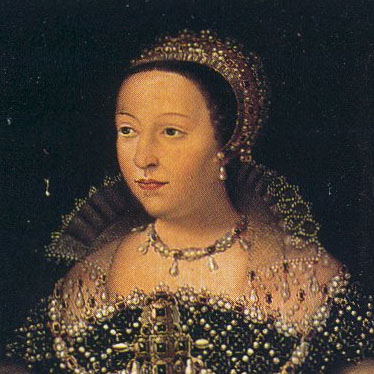
Catherine de Médicis during her reign as Queen Consort of France.
Caterina de’ Medici; known after her marriage as Catherine de Médicis, was the Queen Consort of King Henry II of France. She was born in Florence, Italy in 1519 during the height of the influence of the House of Medici over the arts; a factor that was pivotal in establishing Florence as a cultural centre in Renaissance Italy. This influence was so great that Michelangelo was commissioned to complete the Medici Chapels, with the infamous Basilica di San Lorenzo housing the principle members of the Medici family. The Medici Bank, originating in Rome as the chief bank of the Roman Catholic faith, had been moved to Florence in 1397, therefore establishing the family firmly in the Italian city. The Medici family had also spawned four popes, with Pope Clement VII presiding over the marriage of Catherine and Henry II, the duc d’Orléans in 1533.
Due to her family’s wealth and religious connections, Caterina had been extremely well educated by nuns in both Florence and Rome however her love of architecture flourished in the court of King Francis I, Henry’s father. Despite having ten children together; seven of whom survived and four of those boys, Henry II had a long term affair with his mistress Diane de Poitiers. Henry II became the Dauphin of France upon his elder brother’s death in 1536 and the King of France in 1547, crowning Caterina as Queen Consort Catherine de Médicis. She was appointed Regent during his campaign at the siege of Metz between 1552 and 1553, and was successful in her control of France. She briefly acted as Regent again following Henry’s death in 1559, before the accession of her son Francis.
Following the death of her son King Francis II who had been heavily under the influence of the Guise family, Catherine succeeded in obtaining the regency once again for her son Charles IX. This reign was tarred with the outbreak of the French Wars of Religion which began in 1562 and lasted until 1598. Protestants in France during the 16th and 17th centuries were known as the Huguenots and had been given more religious freedom in the early years of her regency, far more than King Henry II had afforded them. This angered the Guise family who were devoutly Catholic, and led them to slaughter a group of Huguenots in 1562 which sparked the civil wars.
This conflict led to the Massacre of St. Bartholomew’s Day in 1572, a plot that had been orchestrated by Catherine de Médicis. There had been an earlier failed Guise assassination attempt on the Huguenot Admiral Gaspard II de Coligny which Catherine had approved due to fears of his influence over Charles IX and his pending approval of a war against the Catholic country of Spain. Many Protestant dignitaries were attending the wedding of Catherine’s daughter Mary to Huguenot Henry of Navarre (the future King Henry IV of France) and as a result, the French government were investigating the earlier attempt against the Admiral. Concerned that her involvement would be uncovered, Catherine de Médicis devised a second plot in order to assassinate all attending Huguenot leaders and convinced her son Charles IX to consent. On the 24th of August 1572, all of the leaders were assassinated with the exception of Henry of Navarre and Prince Henri de Bourbon-Condé. The violence spread into the 25th despite the passing of a Royal Order, and the homes of other Huguenots across France were attacked and the occupants slaughtered.
Modern historians put the deaths in Paris alone at 3000, with the massacre occurring at many other locations including Rouen, Lyon and Bordeaux. The atrocities were celebrated by Spain and Rome which fuelled the Huguenot rebellion further. Charles IX attempted to hide Catherine’s involvement by claiming there had been a Huguenot attempt on his life, however the conflict carried on after his death in 1574. Catherine de Médicis was granted the regency once again until the coronation of her son Henry III in 1575 who would reign until her death and his murder in 1589. King Henry III implemented the Peace de Monsieur in 1576 on Catherine’s advice, however the conflict began again with the Huguenot Henry of Navarre was made the heir to the French throne in 1584.
-Devon Allen
Junior Girl
Girl Museum Inc.
